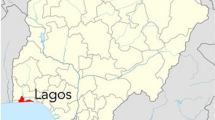Abstract
The endeavor of the present paper is to investigate the existence of chaotic behavior in the underlying dynamics of the total ozone concentration over Arosa, Switzerland (9.68°E, 46.78°N). For this purpose, the correlation dimension method is employed to the mean monthly total ozone concentration data collected over a period of 40 years (1932–1971) at the above location. Based on the observation of a low correlation dimension value of 1 for this data set, the study reports the existence of low-dimensional chaotic behavior in the ozone concentration dynamics.
Similar content being viewed by others
References
Appenzeller C, Weiss AK and Staehelin J (2000). North Atlantic oscillation modulates total ozone winter trends. Geophys Res Lett 27: 1131–1141
Bronnimann S, Luterbacher J, Schumtz C, Wanner H and Staehelin J (2000). Variability of total ozone at Arosa, Switzerland, since 1931 related to atmospheric circulation indices. Geophys Res Lett 27: 2213–2216
Chen JL, Islam S and Biswas P (1998). Non-linear dynamics of hourly ozone concentrations: nonparametric short-term prediction. Atmos Environ 32(11): 1839–1848
Elshorbagy A, Simonovic SP and Panu US (2002). Estimation of missing stream flow data using principles of chaos theory. J Hydrol 255: 123–133
Hood LL, McCormack JP and Labitzke K (1997). An investigation of dynamical contributions to midlatitude ozone trends in winter. J Geophys Res 102: 13079–13093
Henderson HW and Wells R (1988). Obtaining attractor dimensions from meteorological time series. Adv Geophys 30: 205–237
Kugiumtzis D, Lillekjendlie B, Christophersen N (1995) Chaotic time series, Part I: Estimation of some invariant properties in state space. Preprint, pp 1–23
Khan S, Ganguly AR and Saigal S (2005). Detection and predictive modeling of chaos in finite hydrological time series. Nonlinear Process Geophys 12: 41–53
Kocak K, Saylan L and Sen O (2000). Non-linear time series prediction of O3 concentration in Istanbul. Atmos Environ 34(8): 1267–1271
Lee IF, Biswas P and Islam S (1994). Estimation of the dominant degrees of freedom 10 for air pollutant concentration data: applications to ozone measurements. Atmos Environ 28(9): 1707–1714
Men B, Xiejing Z and Liang C (2004). Chaotic Analysis on Monthly Precipitation on Hills Region in Middle Sichuan of China. Nat Sci 2: 45–51
Ott E (1993). Chaos in dynamical systems. Cambridge University Press, Cambridge
Priestley MB (1988). Non-linear and non-stationary time series analysis. Academic, London
Raga GB and Le Moyne L (1996). On the nature of air pollution dynamics in Mexico City—I. Nonlinear analysis. Atmos Environ 30(23): 3987–3993
Schrieber T (1998) Interdisciplinary application of non-linear time series methods. Physics Report 1–86
Sivakumar B (2001). Rainfall dynamics in different temporal scales: a chaotic perspective. Hydrol Earth Syst Sci 5: 645–651
Sivakumar B (2000). Chaos theory in hydrology: important issues and interpretations. J Hydrol 227: 1–20
Sivakumar B, Liong SY, Liaw CY and Phoon KK (1999). Singapore rainfall behavior: Chaotic. J Hydrol Eng ASCE 4: 38–48
Sivakumar B, Berndtsson R, Lall U (2006) Nonlinear deterministic dynamics in hydrologic systems: present activities and future challenges. Nonlinear Process Geophys Preface 1–2
Smale S (1963) Diffeomorphosis with many periodic points. In: Cairns SS (eds) Differential and combinatorial topology. Princeton University Press, Princeton
Smale S (1967). Differentiable dynamical systems. Am Math Soc Bull 73: 748–817
Stehlik J (1999). Deterministic chaos in runoff series. J Hydrol Hydromechanics 47: 271–287
Sander R (1999). Modeling atmospheric chemistry: Interactions between gas-phase species and liquid cloud/aerosol particles. Surv Geophys 20(1): 1–31
Staehelin J, Kegel R and Harris NRP (1998). Trend analysis of the homogenized total ozone series of Arosa (Switzerland). J Geophys Res 103: 8389–8399
Thompson DWJ, Wallace JM and Hegerl GC (2000). Annular modes in the extratropical circulation. Part II: Trends. J Clim 13: 1018–1038
Tsonis AA (1992). Chaos: From theory to applications. Plenum, New York
Varotsos C, Kondratyev KY and Efstathiou M (2001). On the seasonal variation of the surface ozone in Athens, Greece. Atmos Environ 35(2): 315–320
Varotsos C (2005). Power-law correlations in column ozone over Antarctica. Int J Remote Sens 26(16): 3333–3342
Varotsos C and Kirk Davidoff D (2006). Long-memory processes in ozone and temperature variations at the region 60°S–60°N. Atmos Chem Phys 6: 4093–4100
Varotsos C (2004). Atmospheric pollution and remote sensing: implications for the southern hemisphere ozone hole split in 2002 and the northern mid-latitude ozone trend. Adv Space Res 33: 249–253
Weigend S and Gershenfeld NA (1993). Time series prediction: forecasting the future and understanding the past. Santa Fe Institute Studies in the Science of Complexity, vol. XV. Addison-Wesley, New York
Wilks DS (1995). Statistical methods in atmospheric sciences. Academic Press, New York
Wilks DS (1991). Representing serial correlation of meteorological events and forecasts in dynamic decision-analytic models. Mon Weather Rev 119: 1640–1662
Author information
Authors and Affiliations
Corresponding author
Rights and permissions
About this article
Cite this article
Chattopadhyay, G., Chattopadhyay, S. A probe into the chaotic nature of total ozone time series by correlation dimension method. Soft Comput 12, 1007–1012 (2008). https://doi.org/10.1007/s00500-007-0267-7
Published:
Issue Date:
DOI: https://doi.org/10.1007/s00500-007-0267-7




